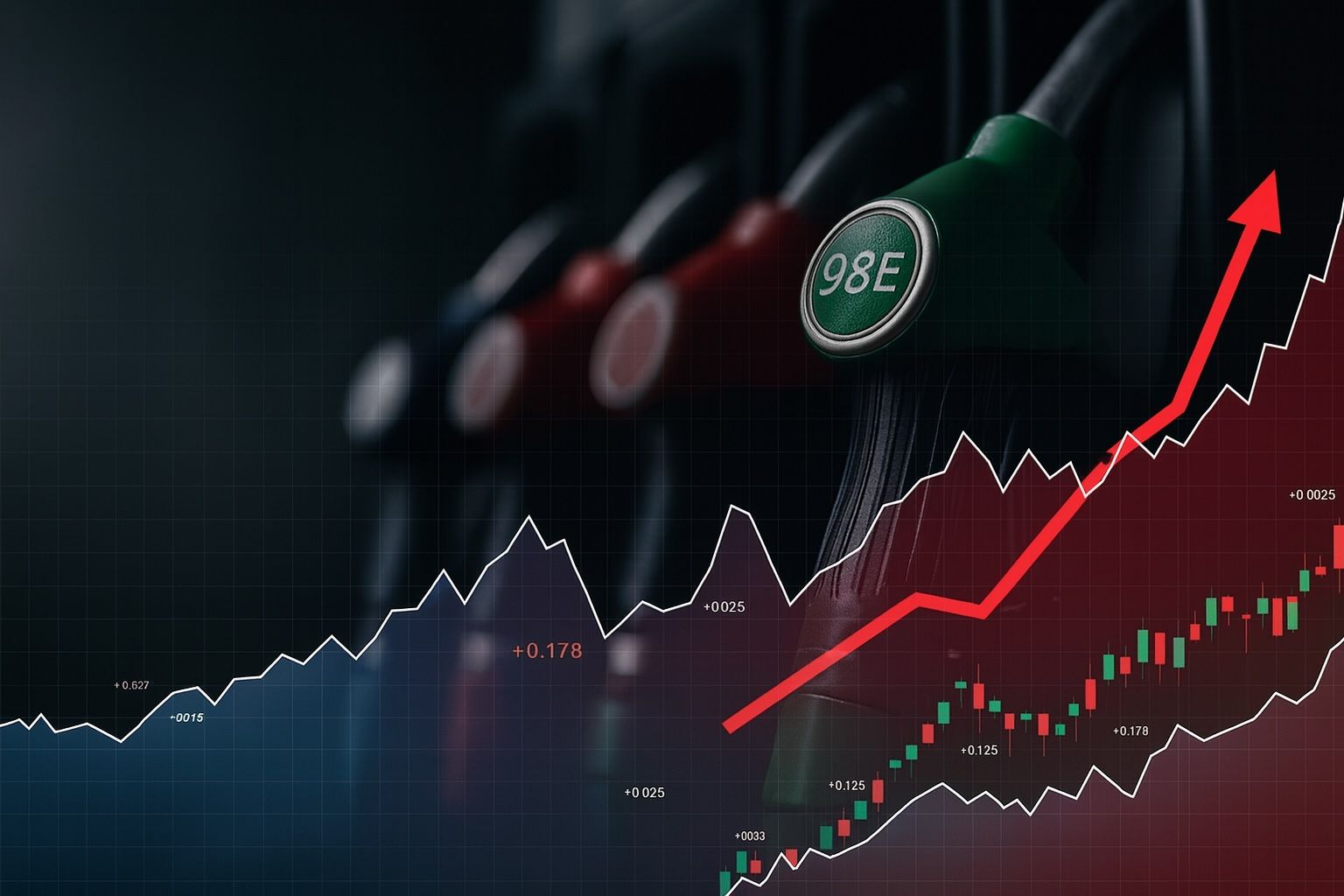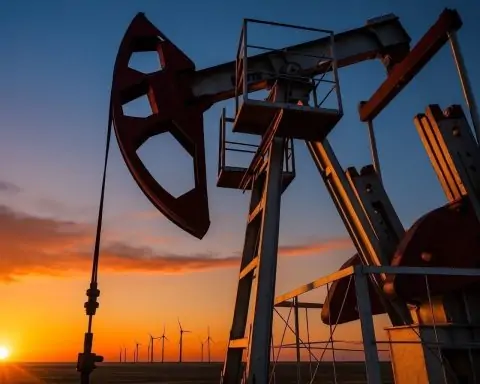- National Average at 4-Year Low: U.S. gas prices have plunged to roughly $3.05 per gallon on average – a milestone not seen since 2021 [1]. One tracker, GasBuddy, even briefly recorded a $2.99 national average this week, marking the first sub-$3 reading in years [2]. Prices are down about 15¢ from a year ago [3] and 40+ states are seeing declines, with at least 32 states now averaging under $3 per gallon [4] [5].
- Oil Prices at Multi-Year Lows: The drop at the pump is driven by a crude oil price crash. U.S. oil (WTI) is trading around $57 per barrel – the cheapest in nearly five years [6] – after falling about 19% from a year ago on fears of a growing supply glut and economic slowdown [7] [8]. Cheaper crude (which makes up ~51% of gasoline’s cost) is directly translating into lower gasoline prices for consumers [9].
- Supply Glut Builds:OPEC+ producers have been boosting output and unwinding past cuts, while U.S. crude production hit a record 13.6 million barrels/day, flooding the market with fuel [10]. In fact, the International Energy Agency warns that if current trends persist, the world could face an “unprecedented” oversupply of about 4 million barrels/day by 2026 [11]. At the same time, new sources from Brazil, Guyana, and others are adding to the surplus. Analysts say “the result is a glut” in oil markets, exerting heavy downward pressure on prices [12].
- Demand Cooling Seasonally:Gasoline demand has eased after the summer driving season, as expected. With fewer drivers on the road post-summer and refiners switching to cheaper winter-blend fuel, fall gas prices typically drop [13]. This year demand is also softer due to economic headwinds – high interest rates and trade tensions are curbing fuel use globally [14] [15]. Notably, a quiet hurricane season meant no major supply disruptions in the Gulf, removing another factor that often props up prices [16]. AAA attributes the recent dip to “lower demand, falling crude oil prices and cheaper winter-blend gas,” along with stable refinery operations [17] [18].
- Forecasts Signal Further Relief: Experts say sub-$3 gas could stick around through the fall and winter barring surprises [19] [20]. “Barring any major disruptions, gas prices are likely to remain slightly below year-ago levels and could stay under $3 for much of the next few months,” predicts GasBuddy’s Patrick De Haan [21]. The U.S. Energy Information Administration (EIA) likewise projects the national average to hover around $3.10 for the rest of 2025 and even dip to about $2.90 in 2026 [22]. AAA reports that robust gasoline inventories and the annual switch to winter fuel mean “consumers are likely to see even lower prices at the pump in the coming weeks” [23].
- Americans’ Wallets Benefit: The gas price plunge is lightening the load on household budgets. U.S. consumers are now spending less than 2% of their disposable income on gasoline – the smallest share since 2005 (aside from the 2020 pandemic anomaly) [24]. With fuel costs down and wages up, gas is consuming the least of Americans’ paychecks in decades [25] [26]. Cheaper energy is also helping cool inflation, after gasoline spikes drove up prices last year [27]. The White House has even touted sub-$3 gas as proof that energy policies are working, though analysts note the drop is largely due to global market forces, not any one administration [28] [29].
- Impact on Oil Industry and Stocks: Tumbling oil prices are squeezing producer profits, forcing some big oil companies to adjust. In Europe, analysts warn that generous shareholder payouts are “unsustainable” if oil stays cheap [30] – BP has already scaled back stock buybacks and TotalEnergies is slowing repurchases amid the downturn [31]. Yet North American energy stocks have been remarkably resilient despite oil’s collapse [32]. “Even as oil crumbles, North American oil stocks have held up,” notes TechStock², pointing to Occidental Petroleum’s shares being buoyed by a $9.7 billion Berkshire Hathaway investment [33]. Some U.S. oil CEOs are planning for a prolonged period of low prices – Occidental’s chief expects oil to remain “range-bound” around $58–$62 through 2026 [34] – while others like ExxonMobil argue today’s glut will be temporary as years of underinvestment eventually tighten supply [35].
Gas Prices Hit Multi-Year Lows Nationwide
American drivers are enjoying a level of pump price relief not seen in several years. The national average price for regular gasoline is now hovering around $3.05 a gallon, the lowest in roughly four years [36]. Just a month ago it was about $3.20, and a year ago it was around $3.20 as well – meaning prices have fallen about 10¢ in the past month and 15¢ versus this time last year [37]. In fact, gas prices have steadily declined for seven straight weeks, reaching their cheapest levels of 2025 so far [38].
Some pricing sources show the key $3 threshold being breached. On Sunday, GasBuddy – which tracks pump transactions – recorded a national average of $2.99 per gallon [39]. This was the first time any tracker saw a “2” handle on U.S. gas since late 2024, and GasBuddy data even hit an intraday low of $2.97 on Monday (the lowest level since 2021) [40]. Official government and AAA estimates have hovered just above $3 (AAA pegged the average at $3.05 mid-week) [41], but the trend is clearly downward across datasets.
Regional differences remain stark. According to AAA, Texas, Arkansas, Wisconsin and other Midwestern/Southern states are now seeing average prices in the $2.60s per gallon [42] – numbers unthinkable a year ago – thanks to abundant local refining and cheaper crude supplies. In at least 32 states, averages are already below $3 [43]. Meanwhile, the West Coast and Hawaii still face far higher prices (e.g. $4.50+ in California and Hawaii) due to supply logistics and state fuel taxes [44]. But even those high-price states have seen relief from their summer peaks. In California, for instance, prices are down from well over $5 last year to the mid-$4 range now.
This nationwide slide is a dramatic turnaround from mid-2022, when drivers grappled with record-high prices above $5 amid a post-pandemic oil crunch. Now, the gasoline market has flipped to favor consumers, delivering real savings. “Americans appear to be on the cusp of seeing the national average drop below $3.00 per gallon and potentially stay there for the first time in years,” says Patrick De Haan, head of petroleum analysis at GasBuddy [45]. De Haan notes that prices have fallen across “the vast majority of the country”, signalling broad-based relief [46]. With many stations in competitive areas already posting high-$2 prices on their marquees, the psychological barrier of “<$3 gas” is swiftly becoming a reality for millions of motorists.
The Perfect Storm: Why Fuel Prices Are Plunging
Multiple factors have combined to send oil and gas prices tumbling. On the supply side, the world is awash in oil. After several years of OPEC+ output cuts and pandemic disruptions, producers have opened the taps again. The OPEC+ alliance (led by Saudi Arabia and Russia) has been gradually restoring production, reversing the deep supply curbs of 2020–22 [47]. Over the past two years, OPEC+ countries have added back millions of barrels per day to the market. At the same time, U.S. oil output has surged to record highs. American drillers are now pumping 13.6 million barrels per day, an all-time peak [48] – thanks in part to improved shale drilling efficiency and high investment when prices were higher.
This gusher of supply is outpacing demand and creating a glut. “The result is a glut,” as oil analyst Andy Lipow told FOX Business, noting that gasoline prices are simply following crude prices lower in line with classic fundamentals [49] [50]. The Energy Information Administration (EIA) reports crude oil inventories have risen to multi-year highs as output exceeds consumption [51] [52]. In fact, the International Energy Agency (IEA) projects that, if producers continue at this pace, the world could see an “unprecedented” oversupply of ~4 million barrels per day by 2026 [53]. “Global inventories are at multi-year highs,” the IEA recently noted, reflecting how rapidly the oil surplus has been accumulating [54] [55].
Several new sources of oil are adding to the wave. Brazil, Guyana, and even smaller producers like Argentina have ramped up output, bringing fresh barrels online [56]. Meanwhile, Russia and Saudi Arabia – eager to regain market share – have been less strict in enforcing output limits lately, allowing more oil onto global markets [57]. The net effect is a crude oil price collapse: benchmark U.S. crude (WTI) recently sank to about $57 a barrel, the weakest price since early 2021 [58]. That’s down from the $70s just a few months ago and over $100 in 2022. “Oil prices have fallen dramatically over the last few weeks as the market sees a growing surplus…tankers loaded with oil [have] nowhere to go,” Lipow observed, adding that even China has been buying up extra oil to stash in its strategic reserves at these bargain prices [59].
Equally important, demand for fuel has been underwhelming. High energy prices earlier in the year, coupled with broader economic softening, have curbed consumption growth. Global economic slowdown fears – including recession worries in Europe and cooling growth in China – are dampening oil demand forecasts [60] [61]. Trade tensions haven’t helped either: when the U.S.–China trade war heated up again this month (with threats of new tariffs), traders feared a hit to oil usage in the world’s two biggest economies [62] [63]. Goldman Sachs recently warned that escalating U.S.–China tariffs and weak economic data could cut global oil demand growth by up to 800,000 barrels/day [64]. In other words, energy consumption isn’t keeping up with the flood of supply.
Seasonal trends are amplifying the decline. Each autumn, U.S. gasoline demand naturally drops off as summer road-trip season ends and Americans drive less. Right on cue, demand fell sharply after Labor Day [65]. Refiners also switched over to “winter blend” gasoline by mid-September – a fuel formulation that is cheaper to produce than summer-grade gas [66] [67]. This switch lowers costs for suppliers and thus prices at the pump. “Refineries are switching to what they call the winter blend, which is a little bit cheaper to produce,” explained NBC business correspondent Brian Cheung, “and there are fewer drivers on the road because we’re past summer… for that reason, demand is down [and] gas prices are [going] down.” [68].
Moreover, this year the Atlantic hurricane season – often a threat to Gulf Coast oil rigs and refineries – was unusually calm at its peak. Unlike some recent years, there were no major storms knocking out refining capacity or disrupting fuel logistics in September/October [69]. “We have been fortunate to avoid gas price disruptions so far from a quiet Atlantic hurricane season,” Money.com noted of this fall’s trend [70]. With both supply surging and demand sagging, it’s a textbook recipe for lower prices. As Citi’s veteran oil analyst Ed Morse summed up, “The market is in a classic cyclical downswing – inventories are building, and demand is disappointingly soft, so prices have to adjust downward.” [71] [72].
Relief at the Pump – and in the Economy
For consumers, the slide in gas prices is unequivocally good news. After years of volatile fuel costs and a spike in 2022, Americans are finally seeing some breathing room in their budgets. The EIA recently projected that U.S. households will spend less than 2% of their disposable income on gasoline in 2025, the smallest share since 2005 (except 2020’s anomaly when lockdowns crushed demand) [73] [74]. “Americans are now spending a smaller portion of their income on gas than they have in years,” GasBuddy’s De Haan observed [75]. With gasoline so much cheaper than a year ago, the average driver is saving hundreds of dollars annually compared to what they might have paid if 2022’s high prices had persisted.
This downturn in pump prices is also helping tame inflation. Gasoline is a major component of the Consumer Price Index (CPI), and last year’s energy spike fed into broader inflation that squeezed consumers. Now that gas is cheaper, headline inflation has been moderating, taking pressure off the Federal Reserve to raise interest rates further. “Lower energy prices are helping cool inflation,” notes TechStock²’s analysis [76] [77]. In September, overall U.S. inflation was lower than expected largely thanks to falling gasoline costs, according to government data. Economists say if gas stays around $3, it will continue to hold down transportation costs and could boost consumer confidence going into the holiday shopping season.
Politically, the gas price retreat has become a talking point in Washington. The White House quickly claimed credit for the sub-$3 milestone, arguing it “proves [that] the president’s relentless commitment to American energy production pays off.” [78] Officials have touted expanded drilling on federal lands and investments in refining capacity as contributing to the price relief. However, industry experts are skeptical that government policy had much to do with this swift drop. “It’s a global commodity,” GasBuddy’s De Haan countered in response to the White House celebration. “There hasn’t been a major policy that’s changed anything to date.” [79] [80] In other words, market forces – chiefly OPEC’s production decisions and global economic trends – are the dominant drivers of gas prices, not short-term policy tweaks. Even the White House’s own Energy Department forecasts had anticipated cheaper fall gasoline due to seasonal patterns and easing oil prices, suggesting this outcome was largely baked in by the market.
Regardless of who gets the credit, everyday Americans are seeing tangible benefits. Lower fuel bills function like a tax cut for consumers: money not spent at the pump can be spent elsewhere in the economy. For example, trucking and delivery companies are enjoying some cost relief, which could translate into slower price increases for goods. Airlines also benefit from cheaper jet fuel. And drivers have extra cash in their pockets – possibly boosting spending on dining, entertainment or holiday gifts. Surveys by AAA have found that when gas prices fall, a portion of drivers report being more likely to take road trips or spend a bit more on other expenses. In short, the gas price crash is providing a welcome financial respite after a period when high energy costs were straining many households.
How Long Will the Slide Last? Forecasts and Risks
The big question now: Will gas prices stay this low – or even go lower? Analysts generally agree that in the near term, prices are likely to remain at or below the current levels as long as there are no major shocks. “The good news may not end if – and when – the national average hits that magical $2.99 mark,” says GasBuddy’s Patrick De Haan, who believes the downtrend could continue in the weeks ahead [81] [82]. With oil markets in surplus and demand entering a winter lull, “a sustained period of sub-$3 gas is possible this fall and winter — if oil prices stay low,” Money.com reports [83] [84]. Similarly, AAA’s fuel analysts are upbeat. Citing healthy gasoline inventories and the cheaper winter blend fuel, AAA stated that “consumers are likely to see even lower prices at the pump in the coming weeks” barring any surprise disruptions [85]. In many regions, especially the South, gas prices “in the $2s” could become commonplace through year-end.
Official forecasts echo this optimism. The U.S. Energy Information Administration’s September outlook projected the average U.S. gasoline price for Q4 2025 will be around $3.10 [86]. In 2026, the EIA expects prices to decline further to about $2.90 on average [87] – a level not seen consistently since the late 2010s. These government forecasts, made when oil was a bit higher, may even prove conservative if the current oil glut persists. Big Wall Street banks have also slashed their oil price forecasts for the next year. For instance, Bank of America now predicts international Brent crude will finish 2025 around $61, and warned that in a worst-case scenario (if OPEC adds even more supply or a recession hits demand) oil could briefly fall below $50 [88] [89]. If such scenarios play out, U.S. gasoline prices could easily sink into the mid-$2 range nationally – levels unheard of since the mid-2010s.
That said, experts caution that oil markets are volatile and cyclical, so today’s low prices shouldn’t be taken for granted. “Predicting gas prices is always difficult” due to the unpredictable nature of global events, Money.com notes [90]. There are a few wildcards that could reverse the trend. One is OPEC+ policy: if oil prices fall “too low” for the likes of Saudi Arabia and Russia, the cartel could decide to cut production again to prop up the market. In the past, OPEC has intervened when Brent crude neared $50. Already, some OPEC ministers have hinted they may revisit output levels at upcoming meetings if oversupply grows. A coordinated cut could tighten supply and push prices back up.
Geopolitical flare-ups are another risk. Currently, global tensions that had elevated oil prices over the summer – such as conflicts in the Middle East – have eased. “Reduced global tensions, specifically in the Middle East, are helping to reduce the price of oil,” noted Phil Flynn of Price Futures Group [91]. However, should a new conflict erupt or an existing one escalate (for example, instability in a major oil-producing region), traders could quickly send crude higher on fear of supply disruptions. Hurricanes or domestic supply issues could also cause temporary price spikes. And as always, refinery outages – whether from accidents or maintenance – can create regional gasoline shortages that boost local prices even if crude is cheap.
Another factor to watch is consumer demand response. Paradoxically, if gas gets too cheap, Americans might drive more, which could firm up demand and put a floor under prices. So far, there’s little evidence of a huge demand rebound – likely because economic factors and seasonal norms are dominating. But come next spring or summer, the usual upswing in driving could stabilize or even lift prices from their winter lows.
Overall though, the consensus is that the U.S. is entering winter with a favorable backdrop for continued low fuel prices. “Barring any major disruptions, gas prices … could stay under $3 for much of the next few months,” De Haan reiterates [92]. The phrase “barring disruptions” does a lot of work there – meaning absent an OPEC move or unexpected shock, the path of least resistance is sideways to down. For now, both futures markets and forecasters are signaling that affordable gas will be around for a while. It’s a welcome development for drivers and a notable turnaround from the expensive energy environment of a year or two ago.
Oil Companies Adjust to Cheaper Oil
While motorists celebrate, the impact of $55–$60 oil is less rosy for the oil industry. Energy companies are seeing thinner profit margins compared to the windfall profits of 2022, prompting strategic shifts. In Europe, several major oil companies have already taken action in response to the price slide. BP – which just a year ago was raking in record earnings – scaled back its share buyback program this quarter to conserve cash as oil revenue falls [93]. France’s TotalEnergies similarly announced it will slow the pace of stock repurchases, a signal that it’s bracing for prolonged lower prices [94]. Analysts warn that if oil stays in the $50s, Big Oil’s generous dividends and buybacks may not be sustainable without adjustments [95]. “Current shareholder payout plans are ‘unsustainable’ if prices stay low,” one analyst cautioned, as reported by TechStock² [96]. European firms, many of whom carry heavy debt loads or are investing in renewables, seem to be battening down the hatches.
In the U.S., oil producers have been more shielded so far. American shale companies had already adopted capital discipline in recent years, and many locked in hedges or fixed-price contracts when prices were higher. Additionally, investor support remains strong for some firms. Notably, Occidental Petroleum’s stock has been buoyed by a massive $9.7 billion investment from Warren Buffett’s Berkshire Hathaway [97], which views the company as a long-term value play. This kind of backing has helped keep Occidental’s share price resilient even as oil prices fell. “Even as oil crumbles, North American oil stocks have held up,” the TechStock² report observed [98]. Indeed, U.S. energy equities as a sector are roughly flat on the year, outperforming the commodity itself – a sign that investors may be looking past the current slump, betting on oil’s eventual recovery or trusting companies to manage costs.
However, U.S. oil executives are not complacent. Many are recalibrating their outlook to a “lower for longer” scenario. Vicki Hollub, CEO of Occidental Petroleum, said recently that she expects oil prices to remain “tight and range-bound” around $58–$62 for the next couple of years [99]. If that forecast holds true, companies will focus on efficiency and returns at mid-range prices, rather than counting on $80+ barrels. Some firms might trim capital spending on expensive new projects, especially higher-cost ventures like deepwater drilling, until markets firm up. Smaller shale producers with higher debt may become acquisition targets if they struggle at $55 oil.
On the other hand, some industry leaders see today’s bargain prices as temporary. Executives at ExxonMobil, for example, argue that the current glut will eventually give way to a tighter market [100]. Their reasoning: years of underinvestment in new oil supply (partly due to the pandemic crash and pressure to pivot to clean energy) could sow the seeds for a supply crunch later in the decade. If companies pull back too much now, supply growth could fall below demand growth a few years out, pushing prices back up. Exxon’s CEO Darren Woods has suggested that beyond 2025, the world may face an oil supply shortfall as decline rates and lack of new mega-projects catch up – implying that today’s low prices are a cycle that will correct in time [101].
In the immediate term, though, the energy sector is prioritizing resilience. Balance sheets are being fortified and cost cuts implemented to ride out the dip. Oilfield service providers are lowering rates to accommodate producers’ tighter budgets. And OPEC+ members, while currently content with high output, are closely monitoring the market – knowing they still have the option to cut production if revenues deteriorate too much.
For now, consumers can take comfort that the interests of oil companies and drivers are temporarily aligned: producers are flooding the market to maximize output, and that glut is delivering low prices to the pump. It’s a delicate balance – too low for too long, and producers will flinch, but until that threshold is reached, drivers can expect to enjoy some of the cheapest gasoline in recent memory. As winter approaches, the rare convergence of ample supply, tame demand, and limited disruptions suggests the gas price reprieve will continue, much to the relief of households and businesses nationwide [102] [103].
Sources: Recent reports from Fox Business [104] [105] [106] [107], Forbes [108], Money.com [109] [110], AAA fuel price data [111] [112], TechStock² (ts2.tech) analysis [113] [114], and U.S. Energy Information Administration projections [115]. These sources include commentary from energy experts like GasBuddy’s Patrick De Haan and Lipow Oil Associates, as well as data from the EIA and AAA. All indicate a sustained downturn in gas prices due to robust oil supply and seasonally weak demand, with expectations of continued consumer relief barring any sudden market changes.
References
1. www.foxbusiness.com, 2. money.com, 3. www.foxbusiness.com, 4. ts2.tech, 5. ts2.tech, 6. ts2.tech, 7. ts2.tech, 8. ts2.tech, 9. www.foxbusiness.com, 10. www.foxbusiness.com, 11. ts2.tech, 12. www.foxbusiness.com, 13. www.foxbusiness.com, 14. ts2.tech, 15. ts2.tech, 16. money.com, 17. www.fox19.com, 18. www.fox19.com, 19. money.com, 20. money.com, 21. money.com, 22. www.foxbusiness.com, 23. money.com, 24. www.foxbusiness.com, 25. www.foxbusiness.com, 26. www.foxbusiness.com, 27. ts2.tech, 28. money.com, 29. money.com, 30. ts2.tech, 31. ts2.tech, 32. ts2.tech, 33. ts2.tech, 34. ts2.tech, 35. ts2.tech, 36. www.foxbusiness.com, 37. www.foxbusiness.com, 38. ts2.tech, 39. money.com, 40. money.com, 41. money.com, 42. www.foxbusiness.com, 43. ts2.tech, 44. www.foxbusiness.com, 45. www.foxbusiness.com, 46. www.foxbusiness.com, 47. www.foxbusiness.com, 48. www.foxbusiness.com, 49. www.foxbusiness.com, 50. www.foxbusiness.com, 51. ts2.tech, 52. ts2.tech, 53. ts2.tech, 54. ts2.tech, 55. ts2.tech, 56. www.foxbusiness.com, 57. www.foxbusiness.com, 58. ts2.tech, 59. www.foxbusiness.com, 60. ts2.tech, 61. ts2.tech, 62. ts2.tech, 63. ts2.tech, 64. ts2.tech, 65. www.foxbusiness.com, 66. www.foxbusiness.com, 67. www.foxbusiness.com, 68. www.foxbusiness.com, 69. money.com, 70. money.com, 71. ts2.tech, 72. ts2.tech, 73. www.foxbusiness.com, 74. www.foxbusiness.com, 75. www.foxbusiness.com, 76. ts2.tech, 77. ts2.tech, 78. money.com, 79. money.com, 80. money.com, 81. ts2.tech, 82. ts2.tech, 83. money.com, 84. money.com, 85. money.com, 86. www.foxbusiness.com, 87. www.foxbusiness.com, 88. ts2.tech, 89. ts2.tech, 90. money.com, 91. www.foxbusiness.com, 92. money.com, 93. ts2.tech, 94. ts2.tech, 95. ts2.tech, 96. ts2.tech, 97. ts2.tech, 98. ts2.tech, 99. ts2.tech, 100. ts2.tech, 101. ts2.tech, 102. money.com, 103. www.foxbusiness.com, 104. www.foxbusiness.com, 105. www.foxbusiness.com, 106. www.foxbusiness.com, 107. www.foxbusiness.com, 108. ts2.tech, 109. money.com, 110. money.com, 111. www.foxbusiness.com, 112. www.foxbusiness.com, 113. ts2.tech, 114. ts2.tech, 115. www.foxbusiness.com










